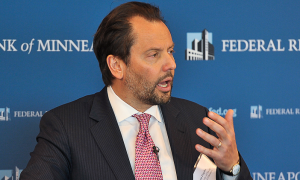Former Fed chairman Ben Bernanke: “Size is not the only relevant attribute of banks.”

Should big banks be broken up in order to ensure the stability of the U.S. financial system? In the past year, this has become one of the central questions of the 2016 presidential election. Bernie Sanders has made the proposed break-up of the country’s largest banks a tenet of his campaign. Meanwhile, Democratic front-runner Hillary Clinton has advocated a more measured approach that focuses on the interconnectedness of financial institutions, but expressed a willingness to break up big banks should it be necessary.
A daylong symposium held at the Federal Reserve Bank of Minneapolis, however, raised questions regarding the efficiency of a big bank break-up, and ended with participants, among them former Federal Reserve chairman Ben Bernanke, largely rejecting the viability of this strategy in securing financial stability.
The symposium was the second symposium on the “Ending Too Big to Fail” initiative that was launched by Minneapolis Federal Reserve President Neel Kashkari earlier this year. Shortly after taking over as head of the Minneapolis Fed in January, Kashkari—a former Treasury official—launched the initiative, seeking solutions to the problem of “too big to fail.” Maintaining that financial reform efforts since the 2008 crisis, including the Dodd-Frank Act, have not gone far enough, in February Kashkari called on policy makers to “give serious consideration” to a number of options, including “breaking up large banks into smaller, less connected, less important entities,” forcing banks “to hold so much capital that they virtually can’t fail,” or taxing leverage “throughout the financial system to reduce systemic risks wherever they lie.”

A majority of the symposium’s participants acknowledged the dangers of “too big to fail,” such as higher risk of financial contagion. Luigi Zingales, a professor at the University of Chicago Booth School of Business (and one of the editors of this blog), focused on the adverse influence of regulatory complexity in banking and the political power of large financial institutions. “The financial crisis has made banks more concentrated, the interests more concentrated, and bankers more powerful,” Zingales said.
While the question of breaking up the largest financial institutions has received much attention in recent months, the speakers and panelists at the Minneapolis Fed symposium remained skeptical. In order to end too big to fail, “there will have to be major structural changes” in the banking sector, said Bernanke (who is currently a fellow at the Brookings Institution), before adding: “the problem is that we really don’t know what those changes are going to need to be.”
In his remarks, which he previewed days earlier in his blog, Bernanke criticized the notion that a breakup of large financial firms will promote financial stability, or mitigate excessive risk taking. In his remarks, Bernanke argued that in addition to the social costs, size also has benefits when it comes to banking. “In the long run, a US financial industry without large firms will likely be less efficient,” he said. The second objection to a bank breakup strategy, he said, was that “size is not the only relevant attribute of banks,” but is only one factor among a number of factors that can lead to a destabilization of the financials system, such as complexity, illiquidity, and interconnectedness.
In lieu of a big bank breakup, participants offered a number of different ways to tackle “too big to fail.” John H. Cochrane, a Senior Fellow at the Hoover Institution at Stanford University, advocated a tax on debt and a move toward “equity-financed banking,” a model in which equity-financing largely replaces short-term debt. “Once we’ve done this, financial crises are over. A 100 percent equity-financed institution cannot fail, and it can’t suffer a run. To fail means you can’t pay your debt. If you don’t any debts, you can’t fail,” said Cochrane, who noted that 100 percent equity is “not necessary” and that 70 percent equity “can work too.”
Regarding the proposed tax on debt, Cochrane advocated it as a simple solution that could prevent a “systemic run” like the 2008 financial crisis, and prevent the need for unnecessary and potentially-harmful regulation. “We need something simple, transparent, and that avoids these pathologies. The best I can think of is a Pigouvian tax, say 5 cents for each dollar of short-term debt (less than a year) and 2 cents for longer term debt. By taxing the amount of debt, arguments about the denominator vanish. So we don’t have to get in to risk weights, leverage, book values, market values, and so forth.”
Other solutions were also raised, such as a reinstitution of Glass-Steagall. While far from perfect, Glass-Steagall is “simpler, voters understand it and maybe can actually support it,” said Zingales, who, like many of the other participants, advocated for simple solutions. “The risk of complex regulation is that it starts as a quasi-decent deal and ends up as a terrible deal,” he said, “the simpler a norm, the fewer provisions there are, and less expensive it is to enforce. The simpler the rule, the more difficult it is for special interests to get away with distorting some technicality that might be hidden in page 942, but could really undermine the entire system.”
In a town hall meeting after the symposium conclude
d, Kashkari again spoke of the need for dramatic measures. “Dodd-Frank wants to keep the same structure and put rules around it,” he said, “now that the economy is stable, it is time to go after transformational solutions.”
“We haven’t decided what the solution is,” he added, “but one of the options is breaking up the banks.”






